tow GMC SIERRA 1996 Owners Manual
[x] Cancel search | Manufacturer: GMC, Model Year: 1996, Model line: SIERRA, Model: GMC SIERRA 1996Pages: 404, PDF Size: 21.57 MB
Page 9 of 404
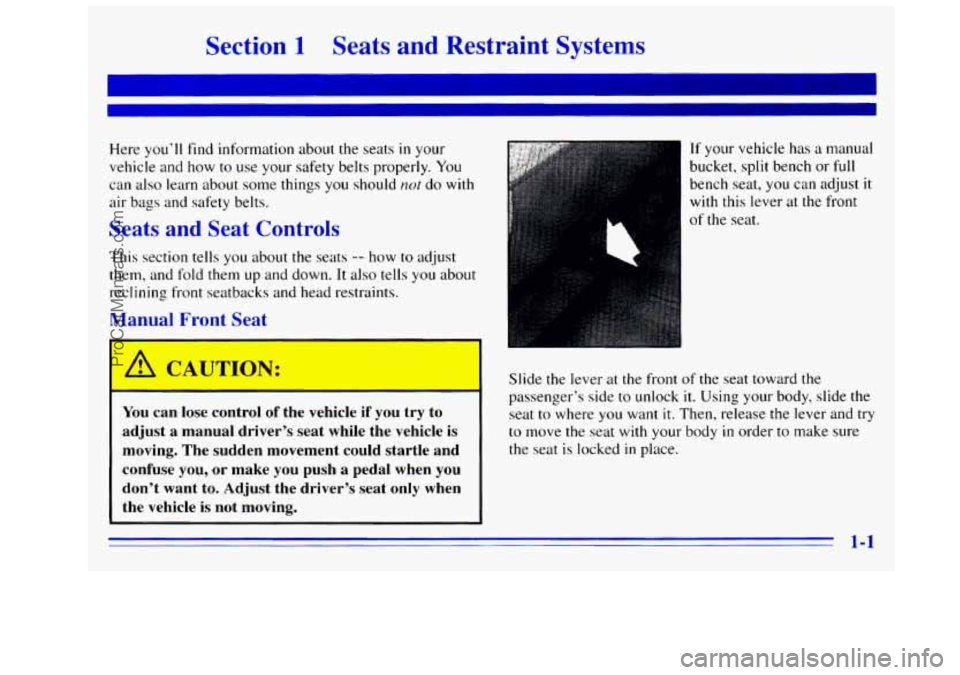
Section 1 Seats and Restraint Systems
Here you’ll find information about the seats in your
vehicle and how to use your safety belts properly.
You
can also learn about some things you should not do with
air bags and safety belts.
Seats and Seat Controls
This section tells you about the seats -- how to adjust
them, and fold them
up and down. It also tells you about
reclining front seatbacks and head restraints.
Mar--a1 Front Seat
CAUTION:
You can lose control of the vehicle if you try to
adjust
a manual driver’s seat while the vehicle is
moving. The sudden movement could startle and
confuse you, or
make you push a pedal when you
don’t want to. Adjust the driver’s seat only when
the vehicle
is not moving.
If your vehicle has a manual
bucket, split bench
or full
bench seat,
you can adjust it
with this lever at the front
of the seat.
~
I
Slide the lever at the front of the seat toward the
passenger’s side to unlock
it. Using your body, slide the
seat
to where you want it. Then, release the lever and try
to move the seat with your body
in order to make sure
the seat
is locked in place.
1-1
ProCarManuals.com
Page 10 of 404
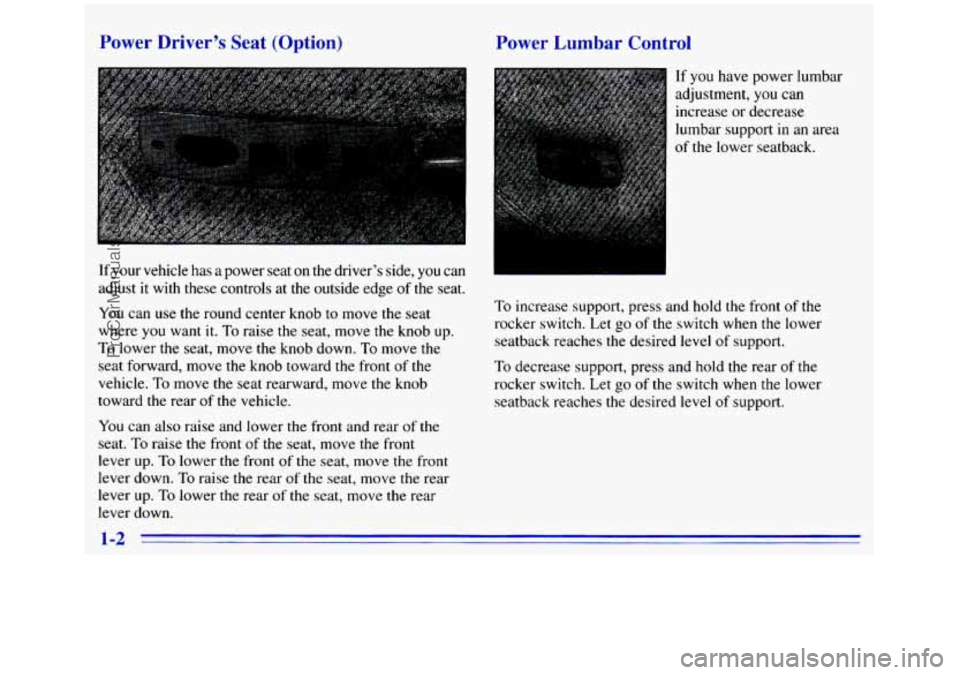
Power Driver’s Seat (Option)
If your vehicle has a power seat on the driver’s side, you can
adjust
it with these controls at the outside edge of the seat.
You can use the round center knob
to move the seat
where
you want it. To raise the seat, move the knob up.
To lower the seat, move the knob down. To move the
seat forward, move
the knob toward the front of the
vehicle.
To move the seat rearward, move the knob
toward the rear of the vehicle.
You can also raise and lower the front and rear
of the
seat. To raise the front of the seat, move the front
lever up.
To lower the front of the seat, move the front
lever down.
To raise the rear of the seat, move the rear
lever up.
To lower the rear of the seat, move the rear
lever down.
Power Lumbar Control
If you have power lumbar
adjustment,
you can
increase or decrease
lumbar support in an area
of the lower seatback.
To increase support, press and hold the front of the
rocker switch. Let
go of the switch when the lower
seatback reaches the desired
level of support.
To decrease support, press and hold the rear of the
rocker switch. Let
go of the switch when the lower
seatback reaches the desired level of support.
1-2
ProCarManuals.com
Page 14 of 404
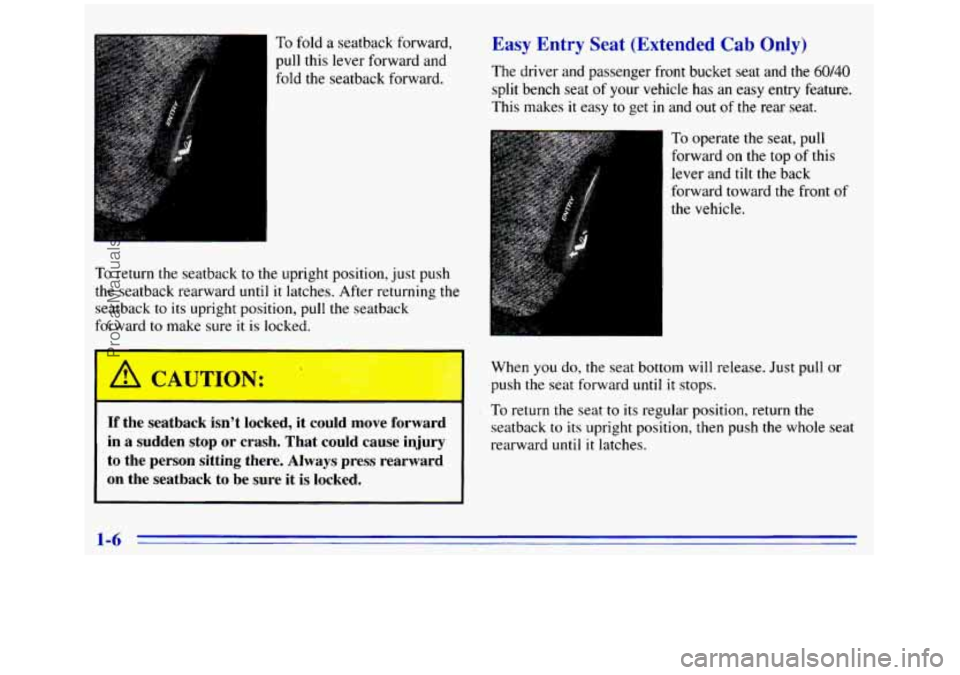
To fold a seatback forward,
pull this lever forward and
fold the seatback forward.
To return the seatback to the upright position, just push
the seatback rearward until it latches. After returning the
seatback to its upright position, pull the seatback
forward
to make sure it is locked.
If the seatback isn't locked, it could move forward
in a sudden stop or crash. That could cause injury
to the person sitting there. Always press rearward
on
the seatback to be sure it is locked.
Easy Entry Seat (Extended Cab Only)
The driver and passenger front bucket seat and the 60/40
split bench seat of your vehicle has an easy entry feature.
This makes
it easy to get in and out of the rear seat.
To operate the seat, pull
forward
on the top of this
lever and tilt
the back
forward toward the front
of
the vehicle.
When
you do, the seat bottom will release. Just pull or
push the seat forward
until it stops.
To return the seat to its regular position, return the
seatback
to its upright position, then push the whole seat
rearward until
it latches.
1-6
ProCarManuals.com
Page 16 of 404
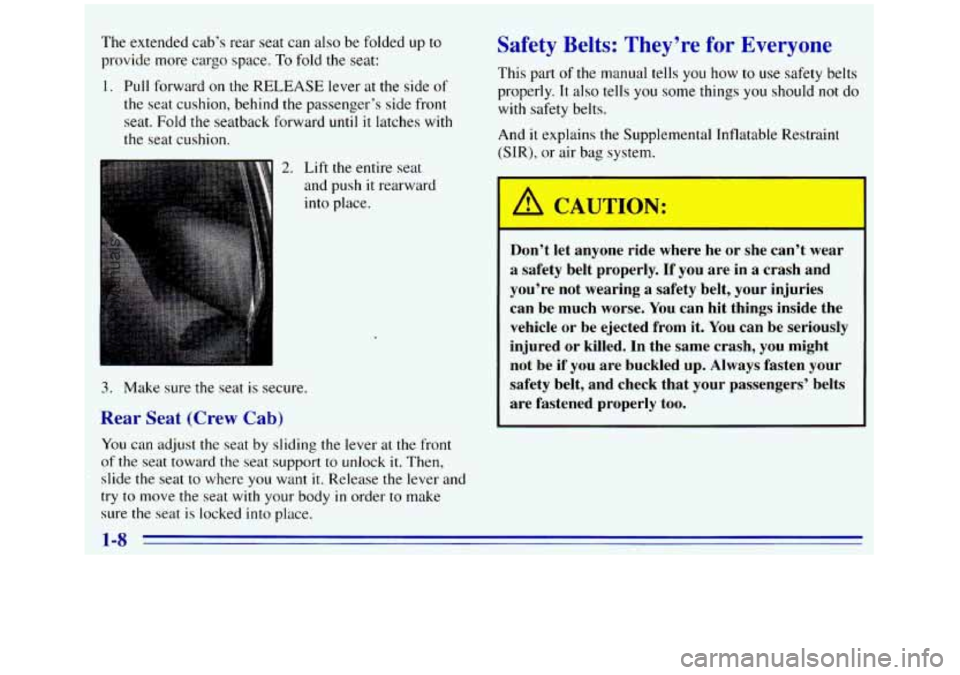
The extended cab’s rear seat can also be folded up to
provide more cargo space. To fold the seat:
1. Pull forward on the RELEASE lever at the side of
the seat cushion, behind the passenger’s side front
seat. Fold the seatback forward
until it latches with
the seat cushion.
2. Lift the entire seat
and push it rearward
into place.
3. Make sure the seat is secure.
Rear Seat (Crew Cab)
You can adjust the seat by sliding the lever at the front
of the seat toward the seat support to unlock it. Then,
slide
the seat to where you want it. Release the lever and
try to move the seat with your body in order to make
sure the seat is locked into place.
Safety Belts: They’re for Everyone
This part of the manual tells you how to use safety belts
properly.
It also tells you some things you should not do
with safety belts.
And
it explains the Supplemental Inflatable Restraint
(SIR), or air bag system.
Don’t
let ady6h K de where he or she can‘t wear
a safety belt properly. If you are in a crash and
you’re not wearing
a safety belt, your injuries
can be much worse.
You can hit things inside the
vehicle or be ejected from it. You can be seriously
injured or killed. In the same crash, you might
not be if you are buckled up. Always fasten your
safety belt, and check that your passengers’ belts
are fastened properly too.
-
1-8
ProCarManuals.com
Page 32 of 404
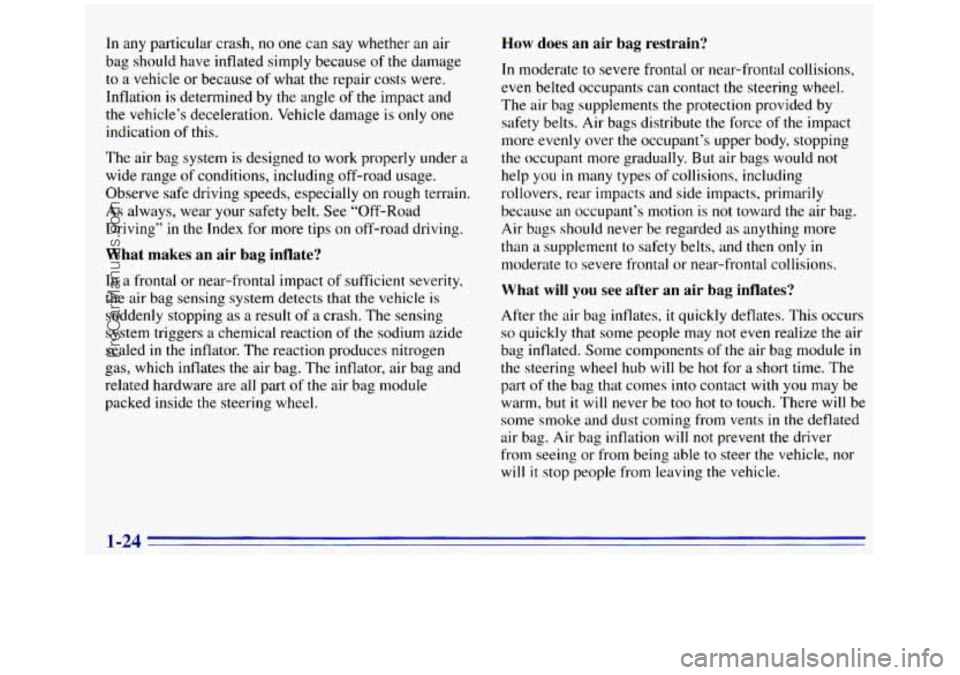
In any particular crash, no one can say whether an air
bag should have inflated simply because of the damage
to a vehicle or because
of what the repair costs were.
Inflation is determined by the angle of
the impact and
the vehicle’s deceleration. Vehicle damage is only one
indication
of this.
The air bag
system is designed to work properly under a
wide range of conditions, including off-road usage.
Observe safe driving speeds, especially
on rough terrain.
As always, wear your safety belt. See “Off-Road
Driving”
in the Index for more tips on off-road driving.
What makes an air bag inflate?
In a frontal or near-frontal impact of sufficient severity,
the air bag sensing system detects that
the vehicle is
suddenly stopping as a result of a crash. The sensing
system triggers
a chemical reaction of the sodium azide
sealed
in the inflator. The reaction produces nitrogen
gas, which inflates the air bag. The inflator, air bag and
related hardware are all part of the air bag module
packed inside the steering wheel.
How does an air bag restrain?
In moderate to severe frontal or near-frontal collisions,
even belted occupants can contact the steering
wheel.
The air bag supplements the protection provided by
safety belts. Air bags distribute the force of the impact
more evenly over the occupant’s upper body, stopping
the occupant more gradually. But air bags would
not
help you in many types of collisions, including
rollovers, rear impacts and side impacts, primarily
because an occupant’s motion
is not toward the air bag.
Air bags should never be regarded as anything more
than a supplement
to safety belts, and then only in
moderate to severe frontal or near-frontal collisions.
What will you see after an air bag inflates?
After the air bag inflates, it quickly deflates. This occurs
so quickly that some people may not even realize the air
bag inflated. Some components
of the air bag module in
the steering wheel hub will be hot for a short time. The
part of the bag that comes into contact with you
may be
warm, but
it will never be too hot to touch. There will be
some smoke and dust coming from vents
in the deflated
air bag.
Air bag inflation will not prevent the driver
from seeing or from being able
to steer the vehicle, nor
will it stop people from leaving the vehicle.
1-24
ProCarManuals.com
Page 58 of 404
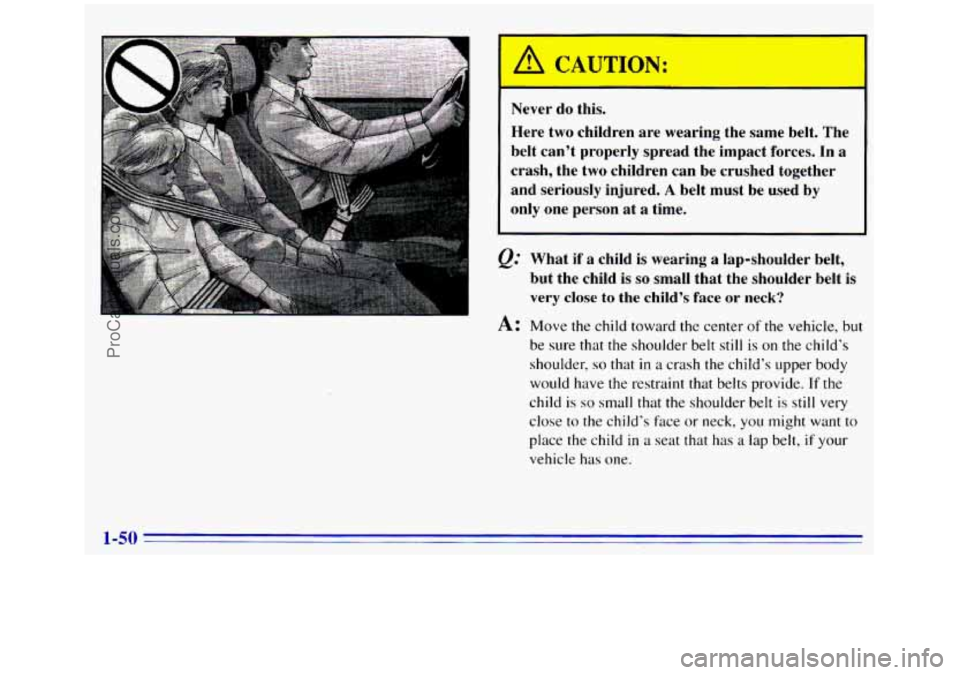
I A CAUTION:
Here two children are wearing the same belt. The
belt can’t properly spread the impact forces. In a
crash, the two children can
be crushed together
and seriously injured.
A belt must be used by
only one person at
a time.
Q=
A:
What if a child is wearing a lap-shoulder belt,
but the child is
so small that the shoulder belt is
very close to the child’s face or neck?
Move the child toward the center
of the vehicle, but
be sure that the shoulder belt still
is on the child’s
shoulder,
so that in a crash the child’s upper body
would have the restraint that belts provide.
If the
child is so small that the shoulder belt is still very
close to the child’s
face or neck, you might want to
place the child
in a seat that has a lap belt, if your
vehicle has one.
1-50
ProCarManuals.com
Page 64 of 404
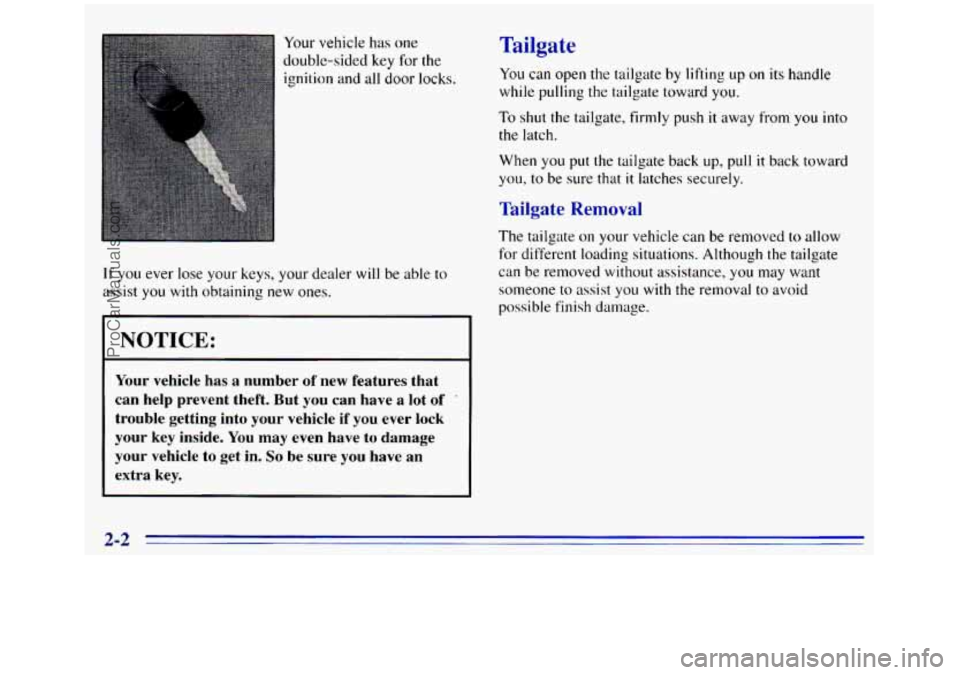
Your vehicle has one
double-sided key for the
ignition and all door locks.
If you ever lose your keys, your dealer will be able to
assist
you with obtaining new ones.
NOTICE:
Your vehicle has a number of new features that
can help prevent theft. But you can have a lot of
.
trouble getting into your vehicle if you ever lock
your key inside. You may even have to damage
your vehicle to get in.
So be sure you have an
extra key.
Tailgate
You can open the tailgate by lifting up on its handle
while
pulling t.he tailgate toward you.
To shut the tailgate, firmly push it away from you into
the latch.
When
you put the tailgate back up, pull it back towara
you, to be sure that it latches securely.
Tailgate Removal
The tailgate on your vehicle can be removed to allow
for different loading situations. Although the tailgate
can be removed without assistance,
you may want
someone to assist you
with the removal to avoid
possible finish damage.
2-2
ProCarManuals.com
Page 70 of 404
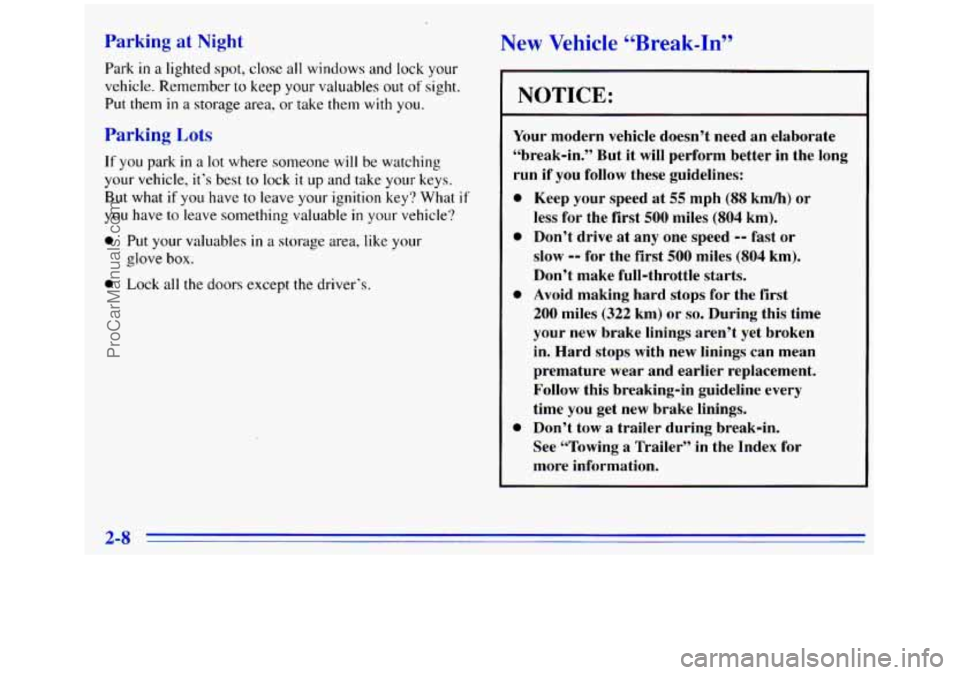
Parking at Night New Vehicle “Break-In”
Park in a lighted spot, close all windows and lock your
vehicle. Remember
to keep your valuables out of sight.
Put
them in a storage area, or take them with you.
Parking Lots
If you park in a lot where someone will be watching
your vehicle, it’s best
to lock it up and take your keys.
But what if you have to leave your ignition key? What if
you have to leave something valuable in your vehicle?
0 Put your valuables in a storage area, like your
glove
box.
0 Lock all the doors except the driver‘s.
NOTICE:
Your modern vehicle doesn’t need an elaborate
“break-in.” But it
will perform better in the long
run
if you follow these guidelines:
0
0
0
0
Keep your speed at 55 mph (88 km/h) or
less for the first
500 miles (804 km).
Don’t drive at any one speed
-- fast or
slow
-- for the first 500 miles (804 km).
Don’t make full-throttle starts.
Avoid making hard stops for the
first
200 miles (322 km) or so. During this time
your new brake linings aren’t yet broken
in. Hard stops with new linings can mean
premature wear and earlier replacement.
Follow this breaking-in guideline every
time you get new brake linings.
Don’t tow a trailer during break-in.
See “Towing
a Trailer” in the Index for
more information.
2-8
ProCarManuals.com
Page 71 of 404
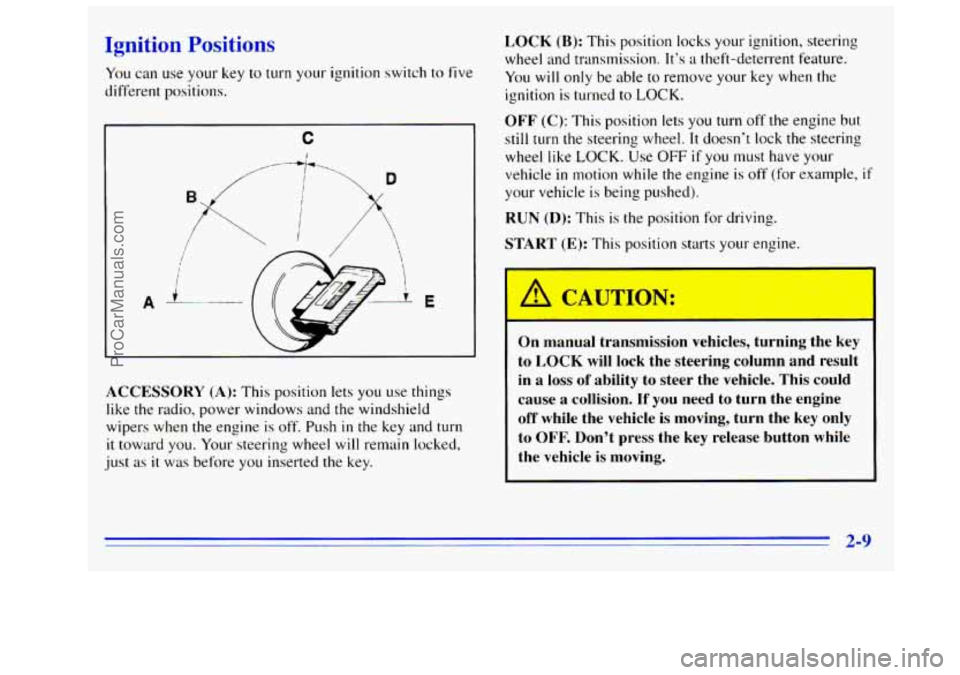
Ignition Positions
You can use your Key to turn your ignition switch to five
different positions.
C
1
E
W
LCCESSORY (A): This position lets you use things
like the radio, power windows and the windshield
wipers when the engine is off. Push
in the key and turn
it toward you. Your steering wheel will remain locked,
just
as it was before you inserted the key. LOCK
(B): This
position locks your ignition, steering
wheel
and transmission. It's a theft-deterrent feature.
You will only be able to remove your key when the
ignition is turned to
LOCK.
OFF (C): This position lets you turn off the engine but
still
turn the steering wheel. It doesn't lock the steering
wheel like
LOCK. Use OFF if you must have your
vehicle in motion while the engine is off (for example, if
your vehicle is being pushed).
RUN
(D): This is the position for driving.
START
(E): This position starts your engine.
I
I A CAUTION:
On manual transmission vehicles, turning the key
to LOCK will lock the steering column and result
in
a loss of ability to steer the vehicle. This could
cause
a collision. If you need to turn the engine
off' while the vehicle is moving, turn the key only
to
OFF. Don't press the key release button while
the vehicle is moving.
ProCarManuals.com
Page 74 of 404
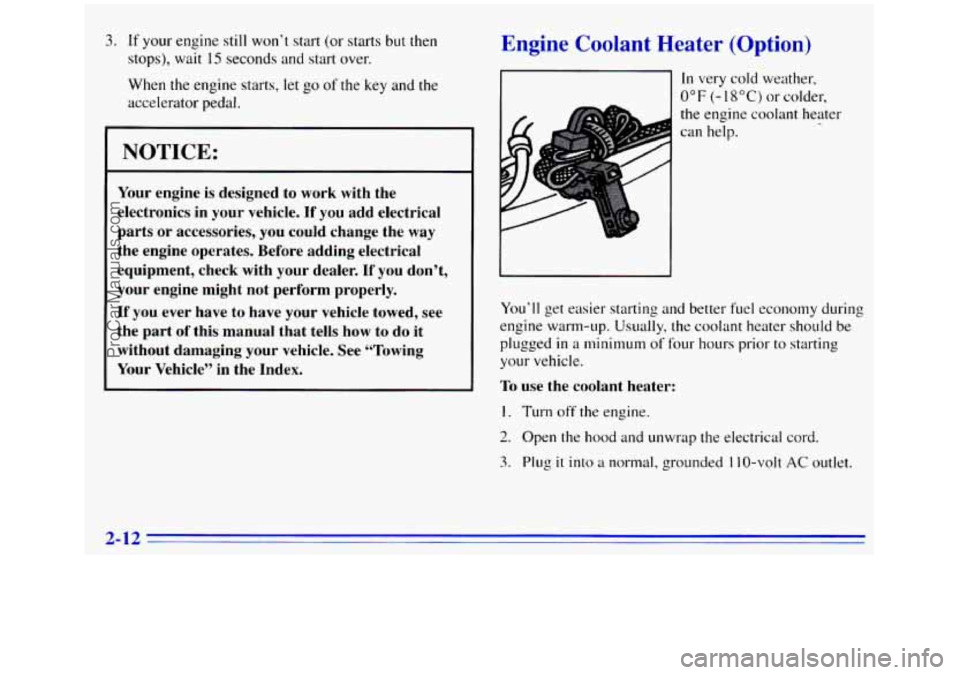
3. If your engine still won’t start (or starts but then
stops), wait
15 seconds and start over.
When the engine starts, let
go of the key and the
accelerator pedal.
I NOTICE:
Your engine is designed to work with the
electronics in your vehicle.
If you add electrical
parts or accessories,
you could change the way
the engine operates. Before adding electrical
equipment, check with your dealer.
If you don’t,
your engine might not perform properly.
If you ever have to have your vehicle towed, see
the part
of this manual that tells how to do it
without damaging your vehicle. See “Towing
Your Vehicle” in the Index.
Engine Coolant Heater (Option)
-
In very cold weather,
0°F (-18°C) or colder,
the engine coolant heater
can help.
You’ll get easier starting and better fuel economy during
engine warm-up. Usually, the coolant heater
should be
pl~~gged in a minimum of four hours prior to starting
your vehicle.
To use the coolant heater:
1. Turn off the engine.
2. Open the hood and unwrap the electrical cord.
3. Plug it into a normal, grounded 110-volt AC outlet.
2-12
ProCarManuals.com